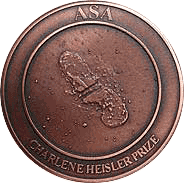
Charlene Heisler Prize
During her short but highly productive career, Dr Charlene Heisler became an internationally-renowned astronomer. She moved to Australia in 1993 to take up a postdoctoral position at the Anglo-Australian Observatory and continued to work in Australian astronomy until her death in 1999 at the age of 37. Charlene was known for her encouragement and guidance of her students, demonstrating that good science is fun and good scientists can be warm, sincere, people. A brief outline of Charlene’s astronomical career has been written by Ray Norris.

The Charlene Heisler Prize is awarded annually by the Astronomical Society of Australia for the most outstanding PhD thesis in astronomy or a closely related field, accepted by an Australian university. The thesis research must show outstanding excellence and originality.
The Prize consists of the Charlene Heisler Medal featuring a multiwavelength view of Centaurus A, together with an award of $1,000 and ASA membership for the following calendar year. The recipient is invited to present a paper on their research at the Annual Scientific Meeting of the Astronomical Society of Australia, where the prize will be presented.
Nominations for the 2025 Charlene Heisler Prize will open in December 2024 with a closing date of mid-February 2025.

Eligibility
- must have had their PhD thesis accepted – but not necessarily conferred – by an Australian university in the previous calendar year.
- must have carried out research in an area of astronomy or closely related field.
Nominations
- each Australian University can submit a maximum of two nominations per year (unless a special case can be made for an additional nomination).
- nominations must be endorsed by the Head of the nominee’s academic unit, in consultation with their academic staff. The Head should also certify that the nominee’s degree requirements have been completed during the previous calendar year.
- nominations must be submitted by the candidate’s supervisor.
- the nomination must include an electronic copy of the thesis.
- the nomination must include a statement from the principal supervisor outlining the thesis results and why they are exceptional. The statement should also include details of the specific contributions of the nominee to the research.
- the nomination may include examiners’ reports on the thesis.
Nominations should be emailed to the ASA Prizes and Awards Coordinator, Dr Tanya Hill – thill@museum.vic.gov.au.
An assessment committee nominated by the ASA Council will evaluate the submitted materials and make a recommendation to the ASA Council. The decision of the ASA Council is final, including any decision not to award a prize in any given year.
Limited travel funds to support attendance at the ASA Annual Science Meeting may be made available at the discretion of the ASA Council.
Previous Winners
- 2023 – Piyush Sharda (Australian National University)
- The role of metals from molecular clouds to galactic discs
- 2022 – Adelle Goodwin (Monash University)
- On the Nature of Neutron Stars in Accreting Systems
- 2021 – Colm Talbot (Monash University)
- Astrophysics of Binary Black Holes at the Dawn of Gravitational-Wave Astronomy
- 2020 – Hayley Macpherson (Monash University)
- Inhomogeneous cosmology in an anisotropic Universe
- 2019 – Adam Thomas (Australian National University)
- The ionising radiation and gas-phase metallicity in the narrow-line regions of Seyfert galaxies
- 2018 – Anish Amarsi (Australian National University)
- Three-dimensional non-local thermodynamic equilibrium radiative transfer and oxygen abundances in late-type stars
- 2017 – Paul Stewart (University of Sydney)
- Stellar Science with Cassini
- 2016 – Vikram Ravi (University of Melbourne)
- Evincing the histories of the cosmic massive black hole and galaxy populations with gravitational waves
- 2015 – Morag Scrimgeour (University of Western Australia)
- Cosmology with Large-scale Structure and Galaxy Flows
- 2014 – Justin Bray (University of Adelaide)
- Lunar Radio Detection of Ultra-High-Energy Particles
- 2013 – Emily Wisnioski (Swinburne University)
- The Kinematic Properties of Clumpy Star-Forming Galaxies
- 2012 – Anthony van Eysden (University of Melbourne)
- Superfluid spin up and pulsar glitch recovery
- 2011 – Max Spolaor (Swinburne University)
- Radial Gradients in Elliptical Galaxies
- 2010 – Adam Deller (Swinburne University)
- Instrumentation, algorithms and pulsar parallax
- 2009 – Brendon Brewer (University of Sydney)
- Applications of Bayesian Probability Theory in Astrophysics
- 2008 – Simon Campbell (Monash University)
- Structural and Nucleosynthetic Evolution of Metal-poor and Metal-free Low and Intermediate Mass Stars
- 2007 – Anna Frebel (Australian National University)
- Abundance Analysis of Bright Metal-Poor Stars from the Hamberg/ESO Survey
- 2006 – Michael Ireland (University of Sydney)
- Optical Interferometry and Mira Variable Stars
The Charlene Heisler prize was established in 2000 by Charlene’s colleagues, with the generous support of many members of the ASA. It was originally offered as a prize to reward excellence at the undergraduate level, on the basis of an essay on an astronomical topic. The inaugural prize was awarded in 2000 to Ewan Cameron from the Australian National University for his essay on ‘Gamma-ray bursts’. Low student interest in subsequent years led to no awards. In 2005, the prize was revised to target high school students, but again the response was disappointing. The first award of the Prize for a PhD thesis was made in 2006.

